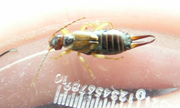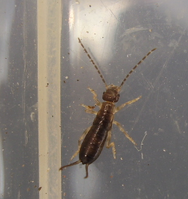Earwigs
[]
Arthropods (Arthropoda)----Insects (Insecta)-----Earwigs (Dermaptera)

An earwig in a defensive pose.
An earwig is an uncommonly encountered insect, and is sometimes found under rocks and damp piles of leaves, more commonly under loose bark of fallen branches from trees.
They do have wings and can fly but seeing an Earwig fly is a rare encounter. The wings are hidden under small leathery "wings" similar to Rove Beetles, and the order name means "Skin wing", referring to this. The world's largest earwig is the Saint Helena Giant Earwig which reaches up to 81mm or 3 inches.
*Some of the About its name content below is from the main Wikipedia website*
About its name[]
The name earwig refers to Old English ēare "ear" and wicga "insect". This was from an Old Wive's tale that female earwigs crawl into your ears and burrow into your brain to lay their eggs, also from the fact that they like to be in warm humid crevices.
Size
[]
Most earwigs are typically 10-13mm or 1/4-1/2 inches.
Feeding[]

The cerci are straight, not curved, meaning this is a female.
Earwigs are Omnivores and will prey on insects and feed on healthy leaves, ripe fruit and sometimes even garbage.
Male and Female[]
Males and females are easily identified by their cerci, or "pinching claws". The male has strongly curved cerci and female has straight ones.
Males cerci are like ( ) from their body, females are like [ ].

An earwig nymph.